Customer orientation: What it is, how to achieve it, and real-life examples

Director of Content

Tags
Share
Customer orientation is all about putting the customer at the heart of your business. Because, at the end of the day, without customers, you don’t have a business at all.
Before I worked in marketing, I worked in customer support—and I can say from firsthand experience that being customer-oriented isn’t something that’s the responsibility of your support agents alone.
Everyone in a company has a hand in making sure that customer needs are met.
In this guide, I’m going to walk you through what customer orientation is, how to encourage folks in different departments outside of support to be more customer-centric, and how other real-life companies are doing this, right now.
What is customer orientation?
Let’s start at the beginning with a quick customer orientation definition. Customer orientation is a business approach that directs your company’s processes, systems, communications, and so on based upon the needs of your customers. After all, acquiring new customers is expensive—why wouldn’t you want to keep them around for as long as possible?
Basically, you’re making it a business goal to keep your customers happy. It sounds like a fluffy thing, but it does impact customer loyalty, customer retention rates, and ultimately, profits. Just ask Zappos. (More on that later.)
Product orientation vs. customer orientation
That’s all very well, but having now read the meaning of customer orientation, you might well be wondering what else a business might focus on instead. Surely all organisations make process and other decisions to align with customer needs, right? Well, no.
Some businesses are product rather than customer oriented. That means they focus on product innovation and improvement, and are generally more inward-looking.
👀 Important note:
When we’re talking about “products” in this context, it doesn’t have to be a tangible item. For businesses that provide a service, like insurance brokers, accountants, etc., their “products” are their service offerings.
Decisions made by product and customer oriented businesses may end up being the same. For instance, both types of company may decide to improve their product or service offering in a similar way.
However, the customer-oriented firm will have come to the decision based on a central desire to understand and fulfil customer needs. The product-oriented company may simply have identified a potential weakness in their product or service offering.
The divergent motivation behind—and root of—business decisions is the main difference between customer orientation and product orientation.
What does it mean to be “customer-oriented?”
Zappos founder, Tony Hsieh, famously believed that "customer service shouldn’t just be a department, it should be the entire company.” (Zappos ended up getting acquired by Amazon for $1.2 billion, so you tell me if so you tell me if this level of extreme customer service orientation worked out for them.)
One of the biggest things that Zappos is known for—and why their customers love them so much—is that every agent is empowered to be customer oriented. From the beginning to the end of the customer journey, they don’t use scripts, they aren’t bound by overly restrictive rules or policies, and they even made sure their website had a good user experience.
Wherever possible, Zappos’ way of being customer oriented very clearly places their customer needs first, sometimes even to the point where it conflicts with conventional business strategy. (Like their 365-day return policy. For shoes? Unheard of.)
It sounds risky, but for Zappos, it paid off.
👀 Want to provide a better customer experience?
Grab The Contact Centre Playbook, which includes real-life case studies and learnings from five contact centre leaders!
The importance of customer orientation in business
So, why is customer orientation important? As mentioned, it’s not the only approach available to your business, and some organisations do go in other directions.
However, there are three principle—and interconnected—benefits of customer
orientation if you do choose to adopt the approach:
Improved customer loyalty: If you successfully make customers the centre of your business, they’re going to notice. Get customer orientation right and your customers will firmly believe that you have their best interests at heart—because you do. That means they’ll be more likely to stick around.
More customer referrals: Those happy, loyal customers aren’t likely to stay quiet about your brand. Instead, they’ll tell their friends and families, and maybe even post positive reviews. Ergo, you’ll get more new customers via referrals.
Greater cost-efficiencies: What’s the net result of more loyal customers—and greater customer retention—and a higher number of referrals? More often than not, money saved on marketing efforts, greater turnover, and a healthier bottom line.
Sure, there are also some disadvantages of customer orientation. It can sometimes be a pricey approach to take (before you start to see the rewards). It can also be difficult to get right, as even your customers themselves might not always know what they want.
However, if you can get it right, a customer orientation strategy can reap significant rewards.
Traits that help build customer relationships
There are several key customer orientation skills or qualities that tend to crop up in my most successful teammates in customer-facing roles. (When I was working in support, I definitely didn’t have all of these skills—that’s why I was never great at it and why I don’t work in that area anymore.) If you’re lucky enough to find an employee who has these traits and who wants to work in customer support, hang on for dear life.
Higher-than-average empathy
Empathy is being able to understand the feelings of others, and if you’re a customer service agent, you need more of it than the average person. You’re not just dealing with other humans—you’re often talking to angry and frustrated people who don’t have a lot of empathy for you. It’s a tough, tough job.
Open-mindedness
Open-minded employees are more likely to consider all angles when planning for the needs of the customer, as well as helping when listening to and implementing feedback.
Adaptability and agility
The needs of the customer are always changing. Agile employees are able to quickly change their approach in order to suit the circumstances. This may mean changing tactics when dealing with different types of customer queries, or quickly pivoting to different strategies if the customer isn’t responding as you hoped.
Conflict resolution
Being able to resolve conflicts calmly is a great skill to have, as we all know that not every customer interaction runs smoothly. It’s important for employees to be able to resolve conflicts amongst themselves, too, especially in cross-functional teams.
Creativity
This one is a bit unique because it’s not limited to your customer-facing teammates. Everyone in your company should feel empowered to do some creative problem solving when they see that there’s a red flag in the customer experience.
Example: I worked at a company where the Legal team noticed that our customers were getting frustrated because of the complicated renewal process, which required a lot of back-and-forth. They ended up revamping that workflow so that it was easy for customers to self-serve. The result: more contract renewals, more profit. Everyone can—and has a responsibility to—be customer-oriented.
4 core components of a basic customer orientation strategy
There are a few initiatives you can include in your customer orientation strategy to help you understand the needs of your customers and implement changes in order to meet those needs.
1. Collect customer feedback regularly
Listening to feedback from the people who actually pay for your goods and services is incredibly important. No matter how well you think your customer care team, SaaS business, or healthcare practice is run, the only way to really know is to ask the people who use them.
One simple way to collect customer feedback is to use customer satisfaction (CSAT) surveys. Typically you’d send these to new or existing customers after a specific interaction like a new purchase or customer support question on the phone.
With Dialpad, you can easily set up a CSAT survey with just a few clicks:
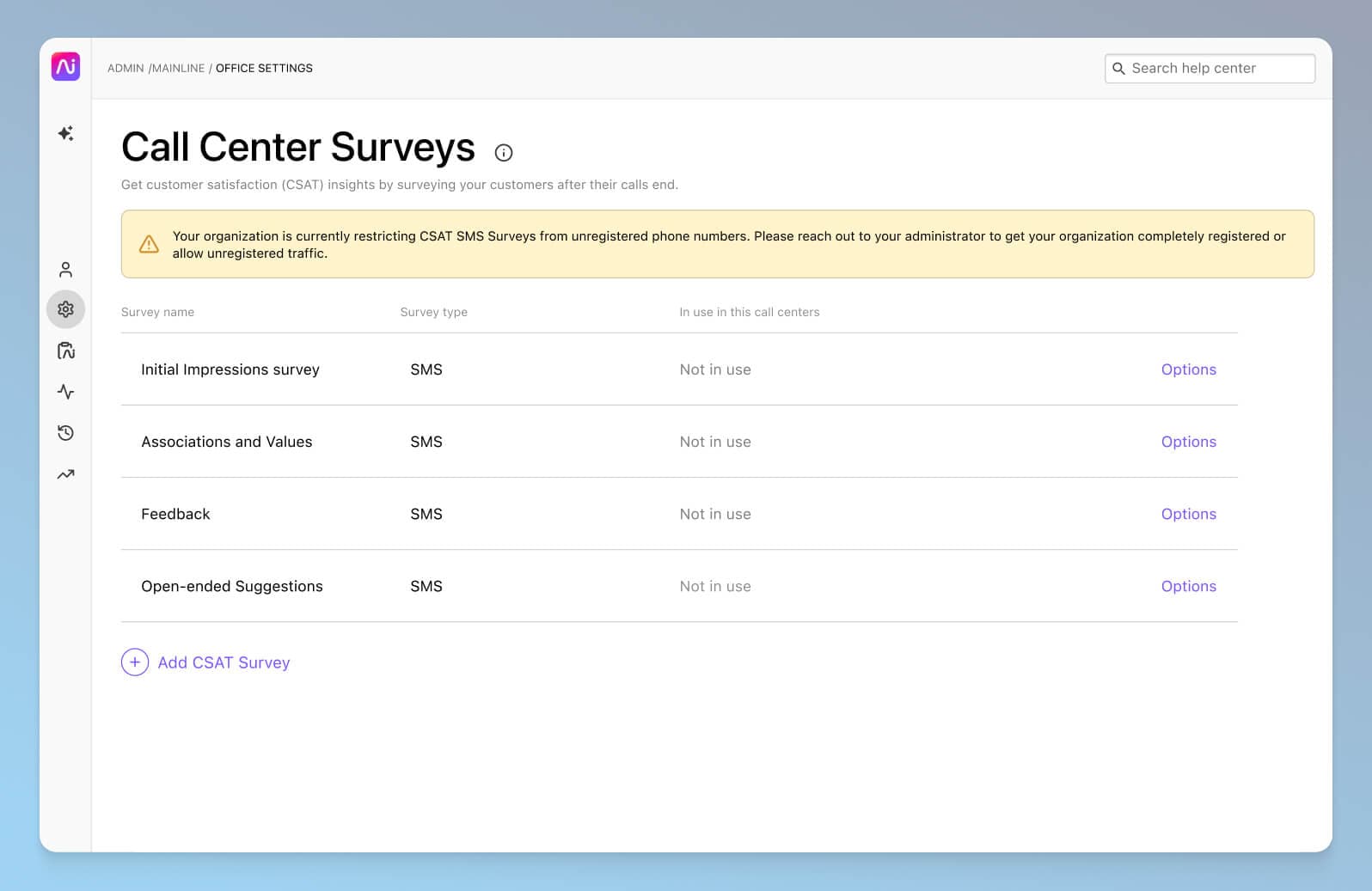
You could also pay attention to what’s being said about your business on social media. Typically, social media is where people take their customer complaints (it’s also a great resource for discovering frequently asked questions about your products or services), and can be a goldmine of insights for your product development team.
Both CSAT surveys and social media have a similar problem though, which is that usually only the most angry and most happy people bother responding to surveys and posting on social media. That means any customer feedback you do see on these channels tends to be very skewed and not representative of overall customer satisfaction.
Fun fact: Dialpad has an Ai CSAT feature that’s designed to solve this. It can analyse your customer conversations and generate an accurate, predictive CSAT score for almost all of those interactions—which means you have a much larger sample size that’s more holistic and gives you a more accurate view of what your customers really think!
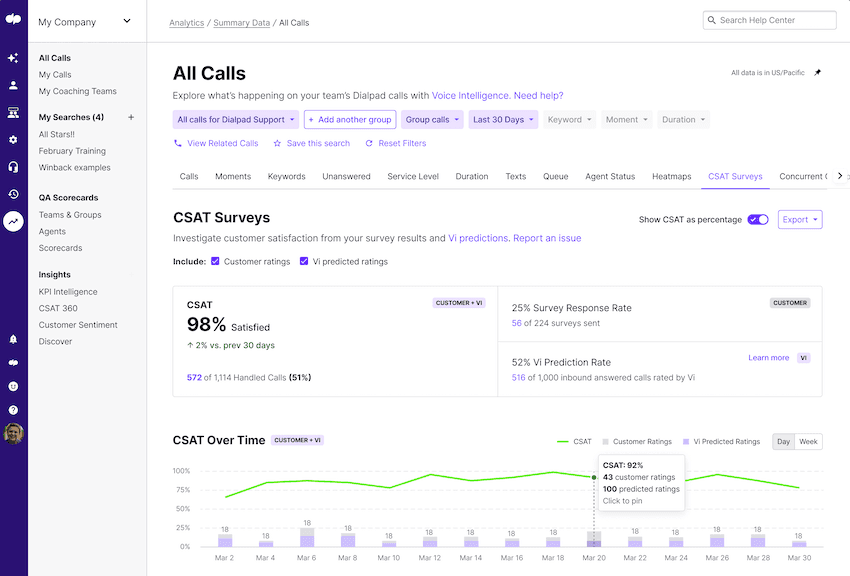
2. Don’t get tunnel vision when it comes to data
When running a customer contact centre, it’s all too tempting to focus on improving single metrics like average handle times or customer survey scores.
While these are important and will help you serve your customers better, you can’t lose sight of your customer experience as a whole.
From chats with our former VP of Customer Experience, one thing she emphasised time and time again when it came to customer engagement metrics was deceptively simple: don’t look at your metrics in a vacuum.
That is, always try to see the bigger picture. If one of your key metrics is spiking (or dipping) dramatically, often it’s not because your agents are somehow messing up all of a sudden—there may be other things going on inside your company, a new announcement in your industry, and more.
Something Jen recommended that I think is very smart is to look at inexplicable changes in performance metrics from an individual or agent perspective first, then expand to a team-wide perspective, then a company-wide perspective, then an industry perspective, and so on. There may very well be factors outside of your team’s immediate control that’s impacting your data!
3. Empower your agents
Your agents are your front line of defence in customer interactions. They probably don’t need you to tell them about the importance of customer focus, but they do need your help in empowering them to do their jobs.
Our support and customer success teams use Dialpad Ai Contact Centre in a ton of different ways—these ones (almost all powered by our powerful, industry-leading Ai technology) keep coming up in my conversations with them.
There are the RTA (Real-Time Assist) cards, which are tailored notes that pop up on agents’ screens when certain keywords or phrases are spoken in a conversation. Our managers can create RTA cards for any topic or tricky question that we get, from pricing to features to objection handling, and set them to trigger automatically:

This way, they don’t have to personally coach every call, and agents (even new hires!) are still empowered to answer questions and solve problems on their own.
Dialpad also has coaching call playlists, which are pretty much what they sound like. Managers can grab call recordings from conversations that are particularly great (or not-so-great), create playlists for specific scenarios (like “best sales discovery call examples”), and share with agents so they can learn on their own time:
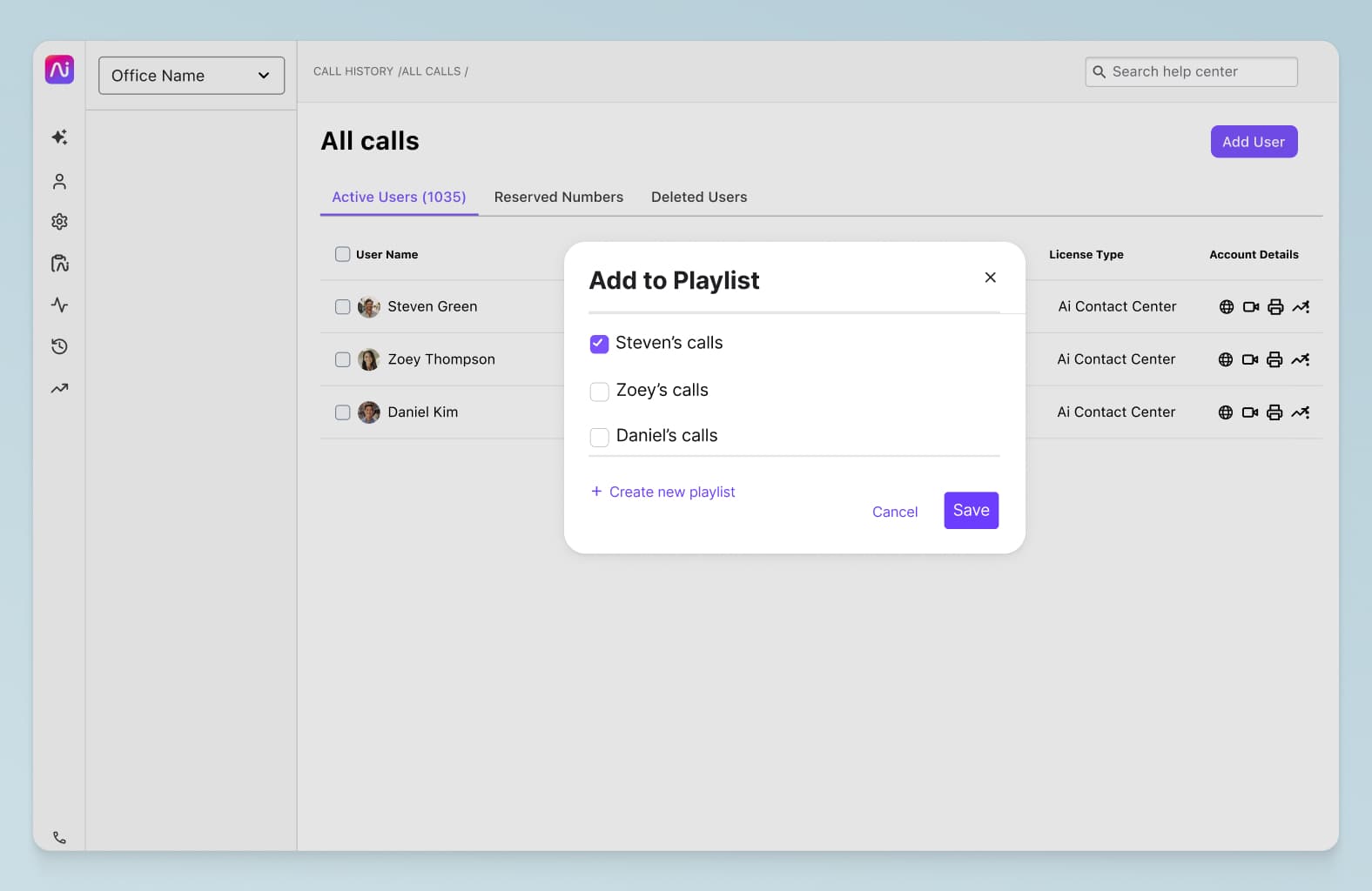
You can empower your agents in different ways—having processes that don’t hamper their ability to do their jobs is one way, but equally importantly, they should have the right software and tools that just make their lives easier, like the examples above.
👉 Dialpad tip:
Learn more about AI in customer service!
4. Systematically involve other departments
Collaboration is incredibly important in many areas of a business, and this is no less true when it comes to dealing with your customers. Every team should have a customer-first approach.
Being able to share information between your customer service, marketing, and sales teams can help you improve customer journey management.
When customers contact you with a question about their purchase, they shouldn’t have to relay all the details of their order back to you. And you shouldn’t have to ask them to wait on hold while you ask a salesperson about that one sale they made four months ago.
Think of it this way: if your competitors are all making them repeat themselves constantly on the phone, but you’re the one of the few businesses (if not the only one) that already knows their relationship history with your company and has all that information ready, that’s a huge competitive advantage. Which would a customer want?
And all you’d really need is customer relationship management (CRM) software that’s easy for your sales, marketing, and customer support teams to access and use—it also helps if it’s integrated with your contact centre platform.
Dialpad, for example, has a range of automations with tons of popular business software. You can embed its dialler in a call centre CRM like HubSpot or Salesforce, and it can auto-log activities and calls for your support and sales teams too:

Even though I work in marketing now, I’m still in our CRM every day. Our sales team is of course the power users, but multiple teams are thinking about our customers, constantly.
Customer orientation examples from 4 real companies
Now, let’s look at some examples of customer orientation from businesses in different industries:
Riders Share
Riders Share calls itself the “Airbnb of motorcycles”, providing a platform for motorcycle enthusiasts to hire bikes or rent out their own. Beginning as a small startup, Riders Share has seen steady and continuing growth. The customer service team has gone from one employee to four, and this number is going up.
How customer-centric are they? Their CEO, Guillermo, helps with customer service too! He handles messages and calls (and it helps that Dialpad is easy to use, I imagine).
“It’s so easy to run the whole contact centre with Dialpad,” says Guillermo. “It’s very user-friendly—I can run analytics super fast, I can change the queue any time, I can see our call history and transfers, and voicemails get transcribed instantly.”
And when it comes to keeping customers happy, Guillermo knows that Riders Share’s customers don’t just call in—they like texting his team too for support. With Dialpad, they can have phone calls and send SMS/MMS messages, all from the same app:
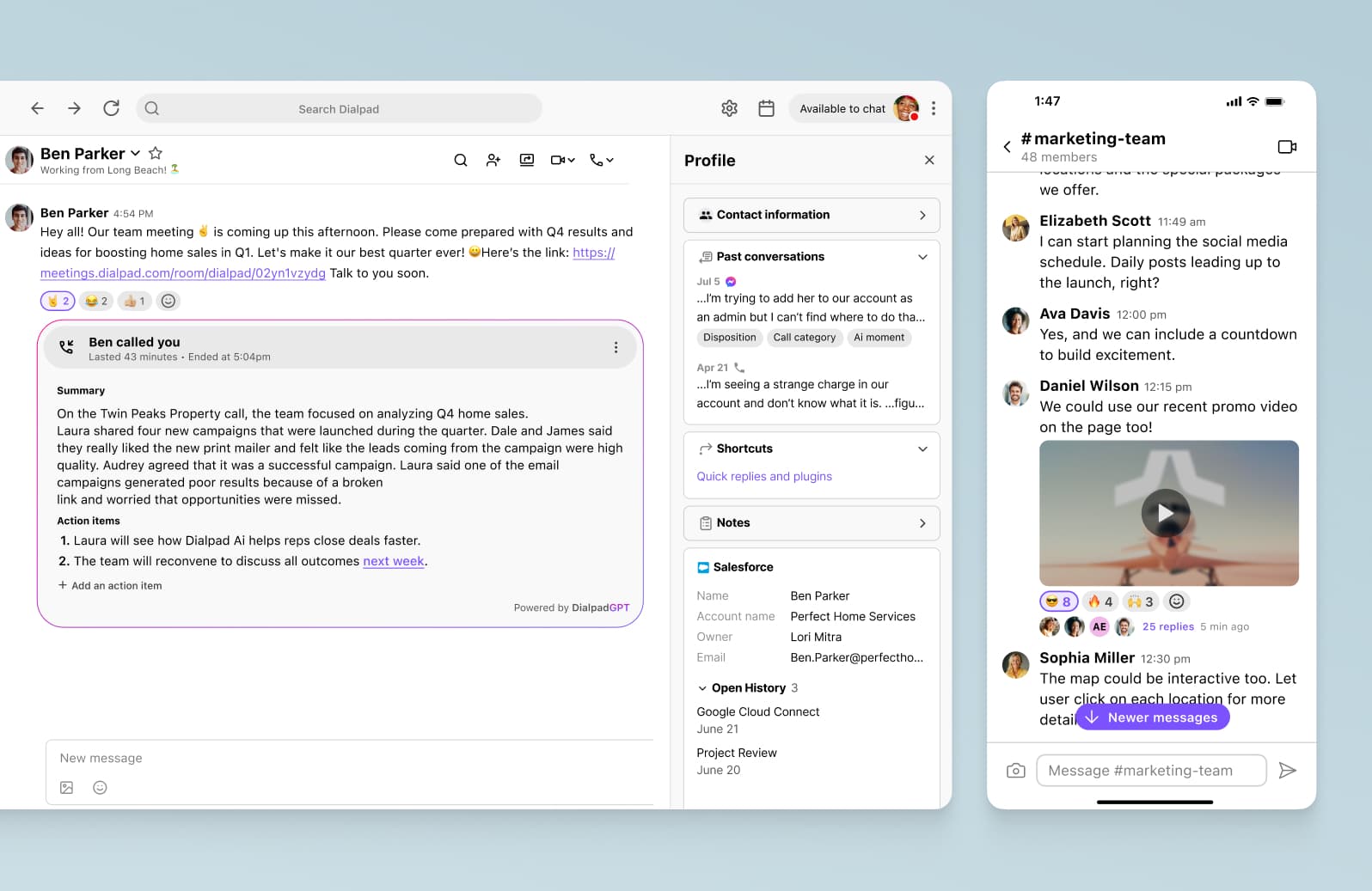
“Customers are so impressed when we’re on a call and I message them the website link they need—usually before they’re even done asking the question! And if I have a missed phone call, I can text them right back.”
CareRev
CareRev helps healthcare professionals to embrace flexible working, providing a service through which they can pick up shifts at hospitals through a mobile app. Unsurprisingly, demand for the service has grown massively since April 2020, with CareRev seeing a whopping 20% month-over-month growth.
This kind of growth meant that CareRev needed a communications platform that could keep up with the higher volumes of calls and enquiries.
One of the biggest issues CareRev was facing? Their phone system just wasn’t up to the job, meaning they were missing on average 36 to 50% of their calls—and it’s hard to be customer-oriented if your customers can’t even talk to you.
So, they switched over to Dialpad Ai Contact Centre. Dionne, CareRev’s Customer Support Operations Manager says that one of the biggest benefits is the improved phone experience for their customers.
“The notifications I receive go straight to my phone to let me know how many agents are available and how many callers are waiting in the queue, and if someone has been waiting over five minutes to get through to the agent,” says Dionne.
Not only that, she can help her agents live on calls too with Dialpad.
“I love that I can see live calls in Dialpad, because I'm able to guide my team members in order to help them before an escalation is needed.”
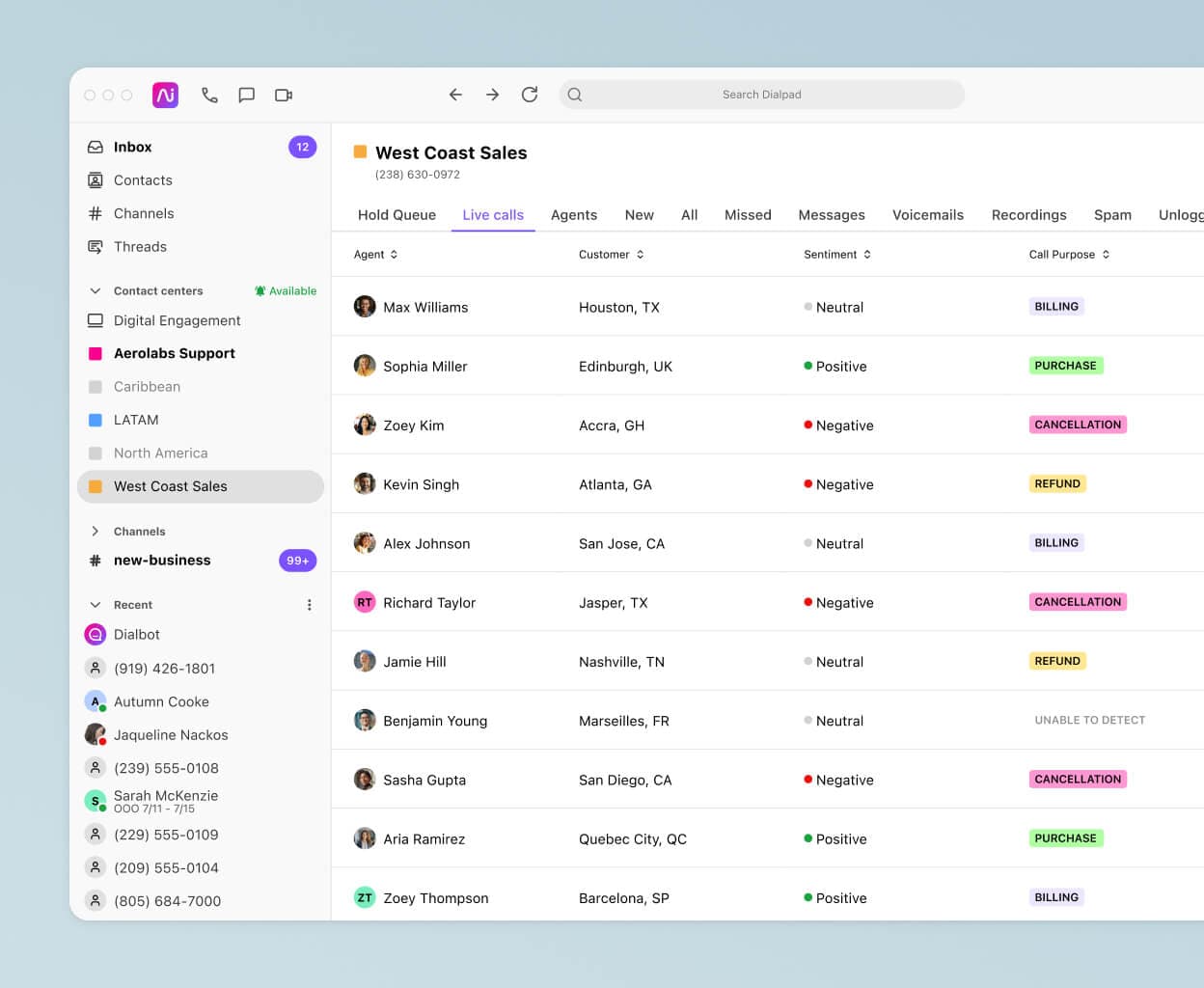
Now, CareRev’s team can spend more of their time on actually communicating with their customers—and their missed call percentage has also dropped to just 3.7% since switching to Dialpad (which their customers probably appreciate)!
Stax
Stax provides over 22,000 businesses with an all-in-one payments API, helping them manage their payment ecosystems and analyse data through fully integrated solutions.
So, they chose a communications platform that integrates with their CRM, HubSpot, and that also makes it easy for their reps to handle the calls that need their specific expertise.
“With the skills-based routing, we can have our reps available for their specialties while still being available to assist when we have those high call volume times, which we can easily see from our dashboard and on the screen around the office,” says Wendy, Stax’s Information Systems Manager.

Dogdrop
Dogdrop offers on-demand doggy daycare and daily dog essentials. The staff at Dogdrop understand that taking care of our furry friends is important, but to truly be customer-oriented, they also have to provide clear, quick communications with their clients / fur parents. To do that, they use Dialpad.
“We have the desktop app open at all times. At Dogdrop, one of our biggest priorities is fast and transparent communication with our daycare members, and the Dialpad desktop app allows us to quickly respond to messages and keep parents updated,” says Shaina, Dogdrop’s Co-founder and CEO.
As Dogdrop looks to expand, they need a communications platform which can scale with them. Dialpad provides just that. It’s quick and easy to add and remove seats as necessary. (It also features competitive pricing, perfect for startups constantly watching their bottom line)!
What does customer orientation mean for your business?
Being customer-oriented isn’t just a way to maximise customer value.
If you want to build a loyal customer base who will return to you with their business over and over again, if you want customers who will stick with you even when your competitors are running flash discount campaigns, if you want the benefits of long-term, strong customer relations...
Then you need a customer orientation strategy.
Remember, anyone in any department can be customer-oriented. From Marketing to Legal to Sales, everyone has the ability to impact different stages of your customer experience. Collaboration and communication between these teams are essential.
Need a communications platform that helps all your teams align on being customer-oriented? Why not get a product tour of Dialpad Ai Contact Centre and see how it can empower your team to serve customers better?
Want to be more customer-oriented?
See how Dialpad Ai Contact Centre can help your agents and supervisors do exactly that with a demo. Or, take a self-guided interactive tour of the app on your own!








